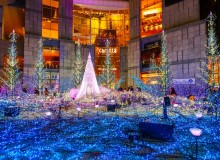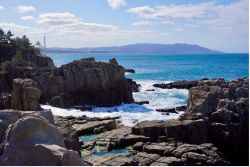
May 17, 2011
Anchor by Anchor
A look at the post-earthquake and tsunami volunteer effort in Miyagi Prefecture
By Metropolis
Originally published on metropolis.co.jp on May 2011
We had a defined objective, which was something: to help the fishermen of Sudachi get their show back on the road. After driving through the unending wreckage of Ishinomaki City—mouths open, wondering where you would ever start—we were happy to have something specific to put our shoulders to.
Oshika-hanto (“Deer Bay”), a peninsular of Miyagi Prefecture, was the closest part of Honshu to the March 11 earthquake’s epicenter. It was also a world-famous oyster producing region until the tsunami destroyed its houses, drowned its residents and emptied the sea of the industry’s materials, scattering them over beach, village and forest. Our efforts there were directed by a small group of local fishermen, who had been at sea on that fateful day. When they noticed the tide draw in dramatically, they headed as far as possible away from land—which is how they survived. But they returned to find their lives and livelihood obliterated.
[youtube]hrblZ01ozMQ[/youtube]
We were 125 student volunteers, brought up by the Nikkei Youth Network from Tokyo in buses loaned by baseball team the Seibu Lions. The mission was fronted by NYN Director, the Chilean-Japanese Akira Uchimura, and Nippon Foundation project coordinator Chikako Masuzaki—both charismatic, energetic leaders. The footsoldiers included 90 Japanese and 35 from an international panorama including Myanmar, Morocco, Peru and more. Housed in a gymnasium where we deposited our equipment (masks, boiler suits, thick gloves, boots) and food (instant ramen, bananas and instant ramen), we traveled two hours to and from Oshika-hanto for each of our three full working days. The journey took us through Ishinomaki where the annihilated buildings and shops, and factories split open like cardboard boxes, strained belief even once seen. The cars struck me the most. Thrown around like toys, crumpled and piled like foil models, sticking out of houses. The playground of a giant, hyperactive child.
[youtube]ZyCrVZSdjQM[/youtube]
Once arrived at the shore, the men were instructed to separate anchors from large piles of tangled debris. The women had to gather strings of shells. Gender equality was not foremost in the fishermen’s mind and no-one raised the issue. Another task was collecting giant, multi-colored buoys, a word pronounced differently by pretty much everyone.
Each usable buoy—i.e. those not filled with water or broken—was worth ¥10,000. The anchors—rusted poles with a heavy, pointed slate at one end and a bar and ring at the other—several times more. The disaster’s financial implications were concretely summed up for me by the piles of both collected by 120 people over three days’ back-breaking work.
I came to enjoy extracting anchors. I would clamber onto a pile of rusted poles, tangled nets, thick ropes, and other miscellany (bikes, furniture, uprooted trees, etc), and use my curved, serrated knife to saw an opening. It was an intellectual and physical exercise to work out which anchor could be removed first and how—while avoiding tetanic nails. Good fun.
My wife was in the shell business. She and her female comrades stacked them into astounding walls stretching every which way. They yanked them out of gutted houses, down from trees—in some places the very ground underfoot was made up of the white discs. After three days you couldn’t walk anywhere without coming across a collection of shells, anchors or buoys. This is a good point at which to explain the oyster farming system.
Anchors are planted into the sea 100 meters apart; between them buoys stud the sea surface. Beneath each hang the shells, strung with wire to form giant necklaces. In August the oysters lay their eggs, which attach themselves to the shell-strings. The fishermen draw up their harvest, and separate the shells. They enfold them one by one into kinks made in a thick rope, and lower them again into the ocean. Two years later the oysters are fully mature and ripe for the international market.
[youtube]faO-2nDNluM[/youtube]
Consequently, once Oshika-hanto’s fishermen manage the gigantic task of reconstructing a system built up and added to over decades, they will hope the oysters still hang around in the murky water. One fisherman told me most marine life had fled. Perhaps four years, he told me. There’s not much to hope for, he concluded, looking out to sea. We stood in silence, not sure what to say. That was the first day.
Others were more upbeat. After initial reticence towards these colorful interlopers, the fishermen warmed to us and grew lively. At our brief goodbye ceremony the head fisherman jokingly arranged a marriage between a young local fisherman and a volunteer; and we were moved by a heartfelt invitation to return in a few years for a big oyster feast.
The difficulty of the recovery had hit me on the second morning when we tried to tackle an immovable pile only to realize an upended forklift truck was at the heart of it. I gazed at the limitless rubble in all directions and felt dizzy at the time and manpower demanded. Yet, once we’d focused on a different area, the positive energy came back. The scale of the task was daunting for us—I can’t even imagine how much for the Tohoku residents. But a fixed objective allowed us to contribute—in a small way at least—to the recovery. Anchor by anchor.
[youtube]zkGbruPYc6w[/youtube]
To volunteer with the Nikkei Youth Network, check out their site here.
See here for more volunteering possibilities.
Japanese translation by Liz Maly







